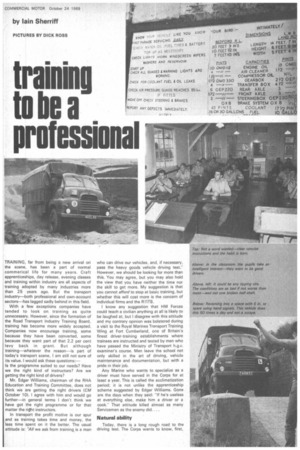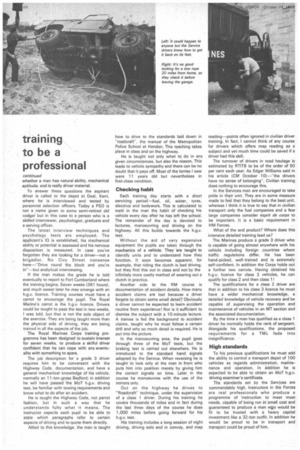training tube a professiona
Page 67

Page 68

If you've noticed an error in this article please click here to report it so we can fix it.
TRAINING, far from being a new arrival on the scene, has been a part of normal commerical life for many years. Craft apprenticeships, day release, evening classes and training within industry are all aspects of training adopted by many industries more than 25 years ago. But the transport industry—both professional and own-account sectors—has lagged sadly behind in this field.
With a few exceptions companies have tended to look on training as quite unnecessary. However, since the formation of the Road Transport Industry Training Board, training has become more widely accepted. Companies now encourage training, some because they have been converted, some because they want part of that 2.2 per cent levy back in grant. But although training—whatever the reason—is part of today's transport scene, I am still not sure of its value. I would ask these questions:—
Is the programme suited to our needs? Have we the right kind of instructors? Are we getting the right kind of drivers?
Mr. Edgar Williams, chairman of the RHA Education and Training Committee, does not think We are getting the right drivers (CM October 10). I agree with him and would go further—in general terms I don't think we have got the right programme or for that matter the right instructors.
In transport the profit motive is our spur and as training takes time and money, the less time spent on it the better. The usual attitude is: -All we ask from training_ is a man who can drive our vehicles, and, if necessary, pass the heavy goods vehicle driving test.However, we should be looking for more than this. You may agree, but you may also hold the view that you have neither the time nor the skill to get more. My suggestion is that you cannot afford to stop at basic training, but whether this will cost more is the concern of individual firms and the Ft IITB.
I know any suggestion that HM Forces could teach a civilian anything at all is likely to be laughed at, but I disagree with this attitude and my contrary opinion was bolstered during a visit to the Royal Marines Transport Training Wing at Fort Cumberland, one of Britain's finest driver-training establishments where trainees are instructed and tested by men who have passed the Ministry of Transport h.g.v. examiner's course, Men leave the school not only skilled in the art of driving, vehicle maintenance and documentation, but with a pride in their job.
Any Marine who wants to specialize as a driver must have served in the Corps for at least a year. This is called the acclimatization period; it is not unlike the apprenticeship scheme suggested by Edgar Williams. Gone are the days when they said: "If he's useless at everything else, make him a driver or a cook." That attitude killed almost as many Servicemen as the enemy did....
Natural ability Today, there is a long rough road to the driving test. The Corps wants to know, first,
whether a man has natural ability. mechanical aptitude, and is really driver material.
To answer these questions the aspirant driver is called to the depot at Deal, Kent, Where he is interviewed and tested by personnel selection officers. Today a PSO is not a name given to some semi-retired old codger' but in this case to a person who is a skilled interviewer, psychologist, graduate and a serving officer.
The latest interview techniques and psycholtigy tests are employed. The applicant's IQ is established, his mechanical ability or potential is assessed and his nervous disposition is measured. In case you've forgotten they are looking for a driver—not a brigadier. No Civy Street nonsense here—"Drive round the block and you're in"----but analytical interviewing.
If the man makes the grade he is told eventually to report to Fort Cumberland where the training begins. Seven weeks (361 hours), and much sweat later he may emerge with an h.g.v. licence. Training courses must have a carrot to encourage. the pupil. The Royal Marine's carrot is the h.g.v. licence. Drivers could be taught to pass the test in two weeks, I was told, but that is not the sole object of the exercise. They are being taught more than the physical side of driving, they are being trained in all the aspects of the job.
The Royal Marines Corps training programrne has been designed to sustain interest for seven weeks, to produce a skilful driver confident that he can cope with any eventuality with something to spare.
The job description for a grade 3 driver requires him to be conversant with the Highway Code,, documentation, and have a general mechanical knowledge of his vehicle, normally an 11-ton-gross Bedford; in addition he will have passed the MoT h.g.v. driving test, be familiar with towing requirements and know what to do after an accident.
He is taught the Highway Code, not parrot fashion, but in such a way that he understands fuily what it means. The instructor expects each pupil to be able to state which paragraphs refer to certain aspects of driving and to quote them directly, Allied to this knowledge, the man is taught how to. drive to the standards laid down in "roadcraft", the manual of the Metropolitan Police School at Hendon. This teaching takes place in class and on the highway.
He is taught not only what to do in any given circumstances, but also the reason. This leads to vehicle sympathy and there can be no doubt that it pays off. Most of the lorries I saw were 11 years old but nevertheless in first-class condition,
Checking habit
Each training day starts with a short servicing period—fuel, oil, water, tyres, electrics and bodywork. This is calculated to instil in the man the habit of checking his vehicle every day after he has left the school. The remainder of the day is devoted to lectures, manoeuvring and driving on the highway. All this builds towards the h.g.v. test.
Without the aid of very expensive equipment the pupils are taken through the mechanics of a vehicle. They are taught to identify units and to understand how they function. It soon becomes apparent, for example, that riding the clutch is bad driving, but they find this out in class and not by the infinitely more costly method of wearing out a clutch in practice.
Another side to the AM course is documentation of accident details. How many accident claims are lost because a driver forgets to obtain some small detail? Obviously a driver cannot be expected to learn accident routine from experience! Nor is it-sufficient to dismiss the subject with a 10-minute lecture. A trainee is fed the background to accident claims, taught why he must follow a certain drill and why so much detail is required. He is put into the picture.
In the manoeuvring area, the pupil goes through three of the MoT tests, but the braking test is carried out elsewhere. He is introduced to the standard hand signals adopted by the Service. When reversing he is taught to look only at the man in' front who puts him into position merely by giving him the correct signals on time. Later in the course he manoeuvres with the use of the mirrors only.
Out on the highway he drives to "Roadcraft" technique, under the supervision of a class 1 driver. During his training he covers thousands of miles and in fact during the last three days of the course he does 1,000 miles before going forward for his h.g.v. test.
His training includes a long session of night driving, driving solo and in convoy, and map reading—points often ignored in civilian driver training. In fact, I cannot think of any course for drivers which offers map reading as a subject and yet much time could be saved if 'a driver had this skill.
The turnover of drivers in road haulage is estimated by R11TB to be of the order of 50 per cent each year. As Edgar Williams said in his article (CM October 101---"the drivers have no sense of belonging". Civilian training does nothing to encourage this.
In the Services men are encouraged to take pride in their unit. They are in some measure made to feel that they belong to the best unit, whereas I think it is true to say that in civilian transport only the fuel companies and a few large companies consider esprit de corps to be important. It is a basic requirement in HM Forces.
What of the end product? Where does this intensive detailed training lead us?
The. Marines produce a grade 3 driver who is capable of going almost anywhere with his vehicle including foreign countries where traffic regulations differ. He has been hand-picked, well-trained and is extremely self-confident. In addition the Corps holds out a further two carrots. Having obtained his h.g.v. licence for class 3 vehicles, he can qualify for class 2 and then class 1!
The qualifications for a class 2 driver are that in addition to his class 3 licence he must have a wider mechanical knowledge, a detailed knowledge of vehicle recovery and be capable of supervising the operation and maintenance of vehicles in an MT section and the associated documentation.
By the time a man has qualified as a class 1 driver he normally holds the rank of sergeant. Alongside his qualifications, the proposed requirements for a TML fade into insignificance.
High standards
To his previous qualifications he must add the ability to control a transport depot of 100 vehicles as regards administration, maintenance and ()natation. In addition he is expected to be able to obtain an MoT h.g.v. driving examiner's certificate.
The standards set by the Services are commendably high. Instructors in the Forces are real professionals who produce a programme of instruction to meet most needs, capable of being run at small cost and guaranteed to produce a man vittio would be fit to be trusted with a heavy capital investment like a 32-ton outfit. In addition he would be proud to be in transport and transport could be proud of him.




















































































































